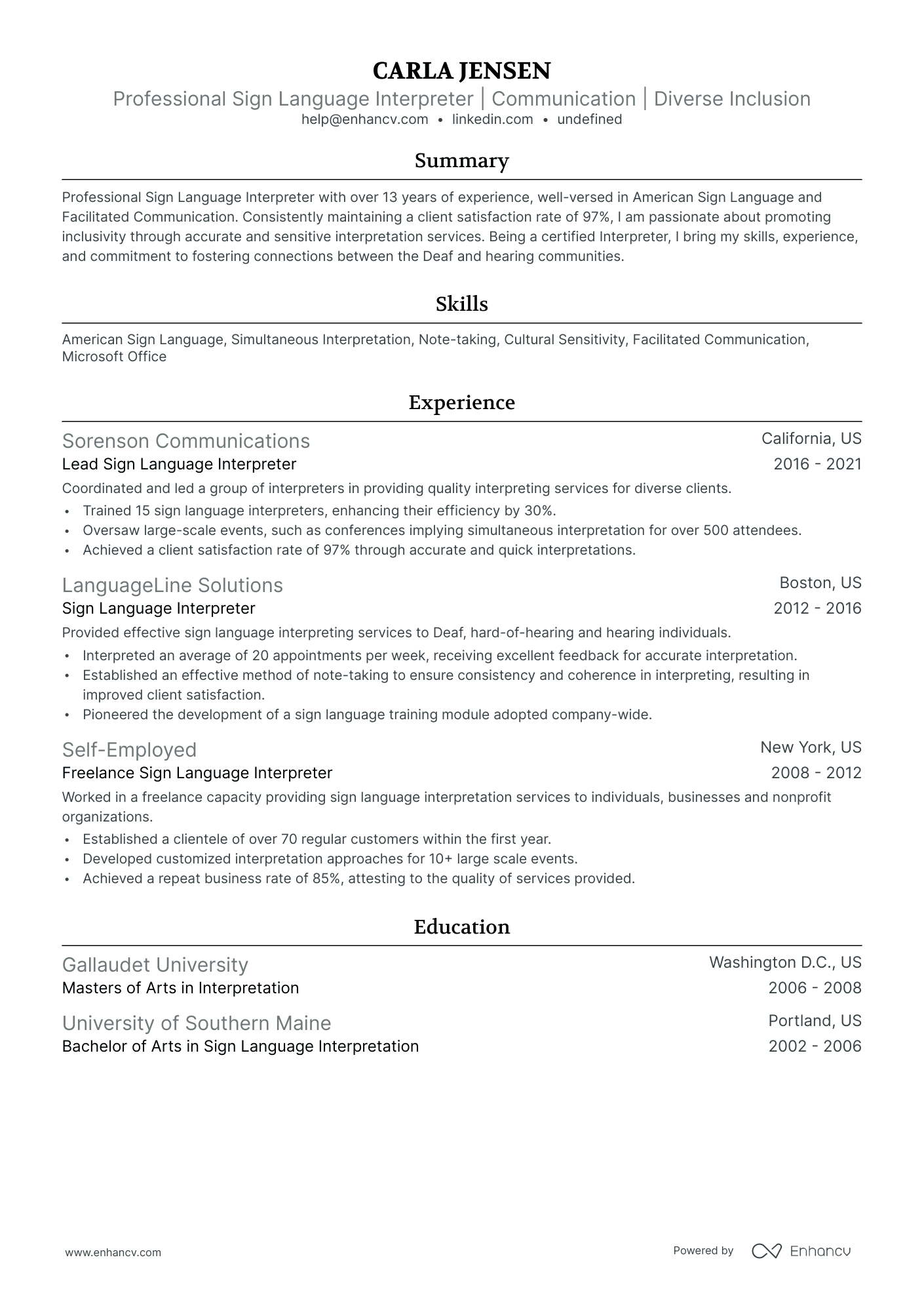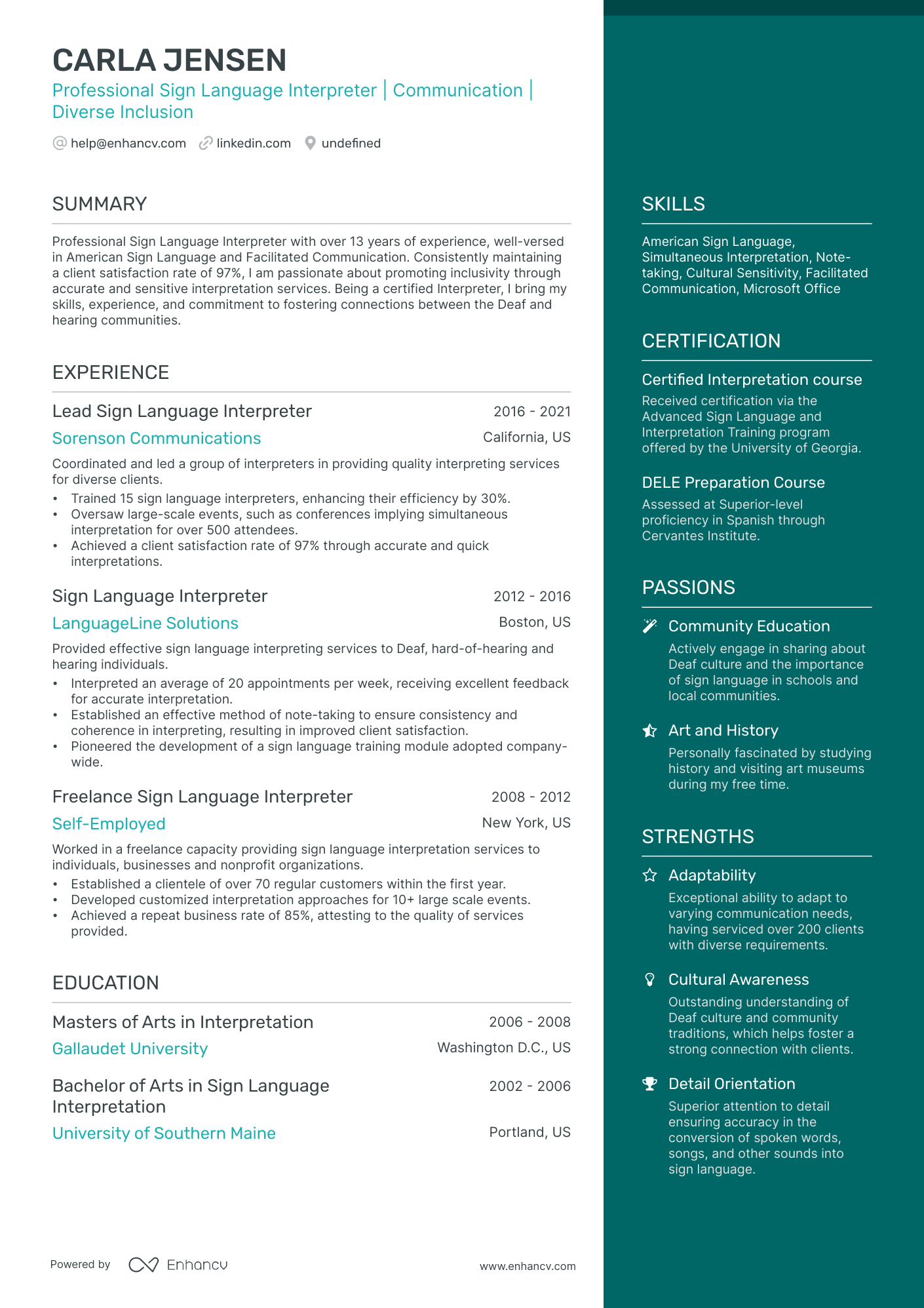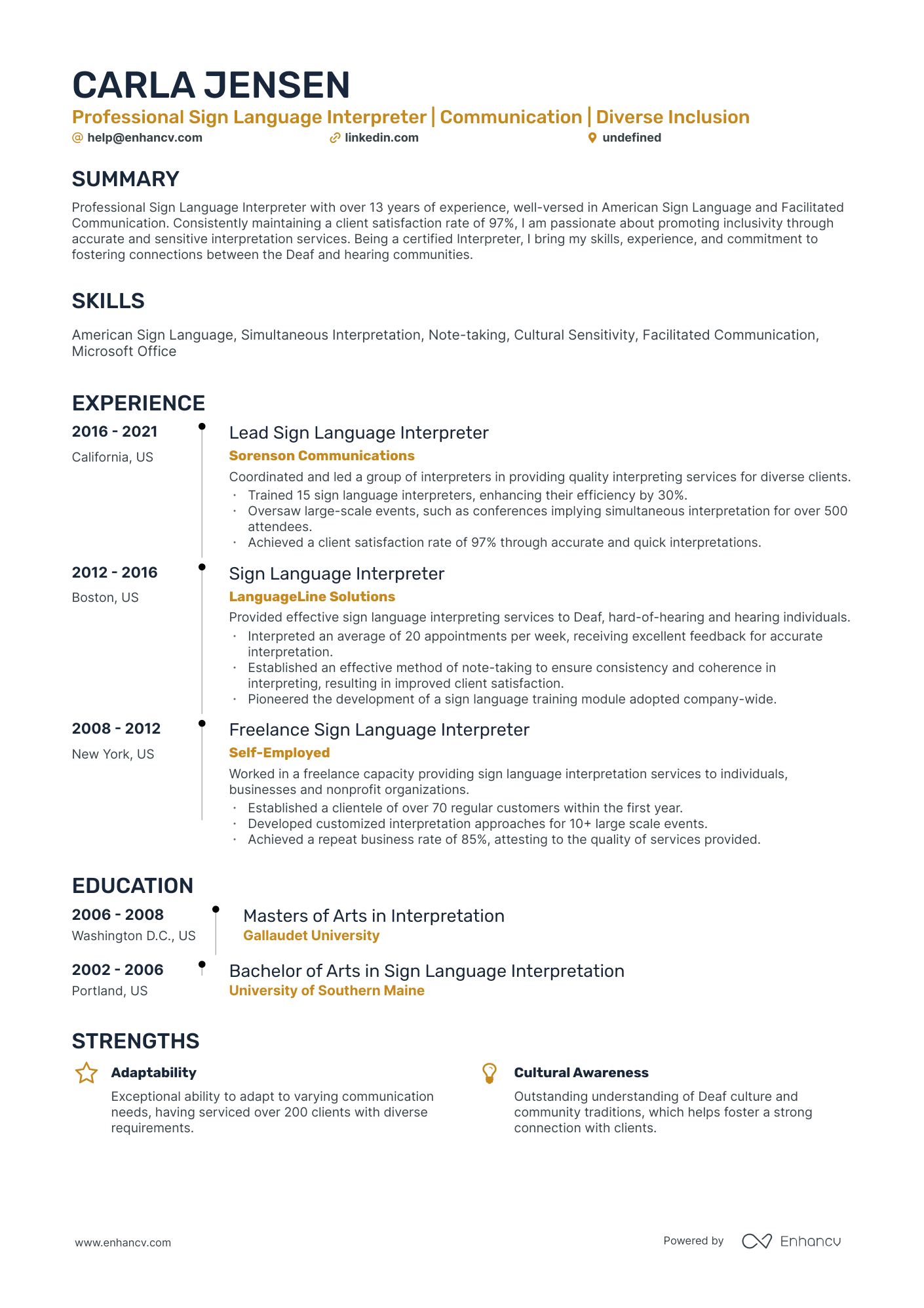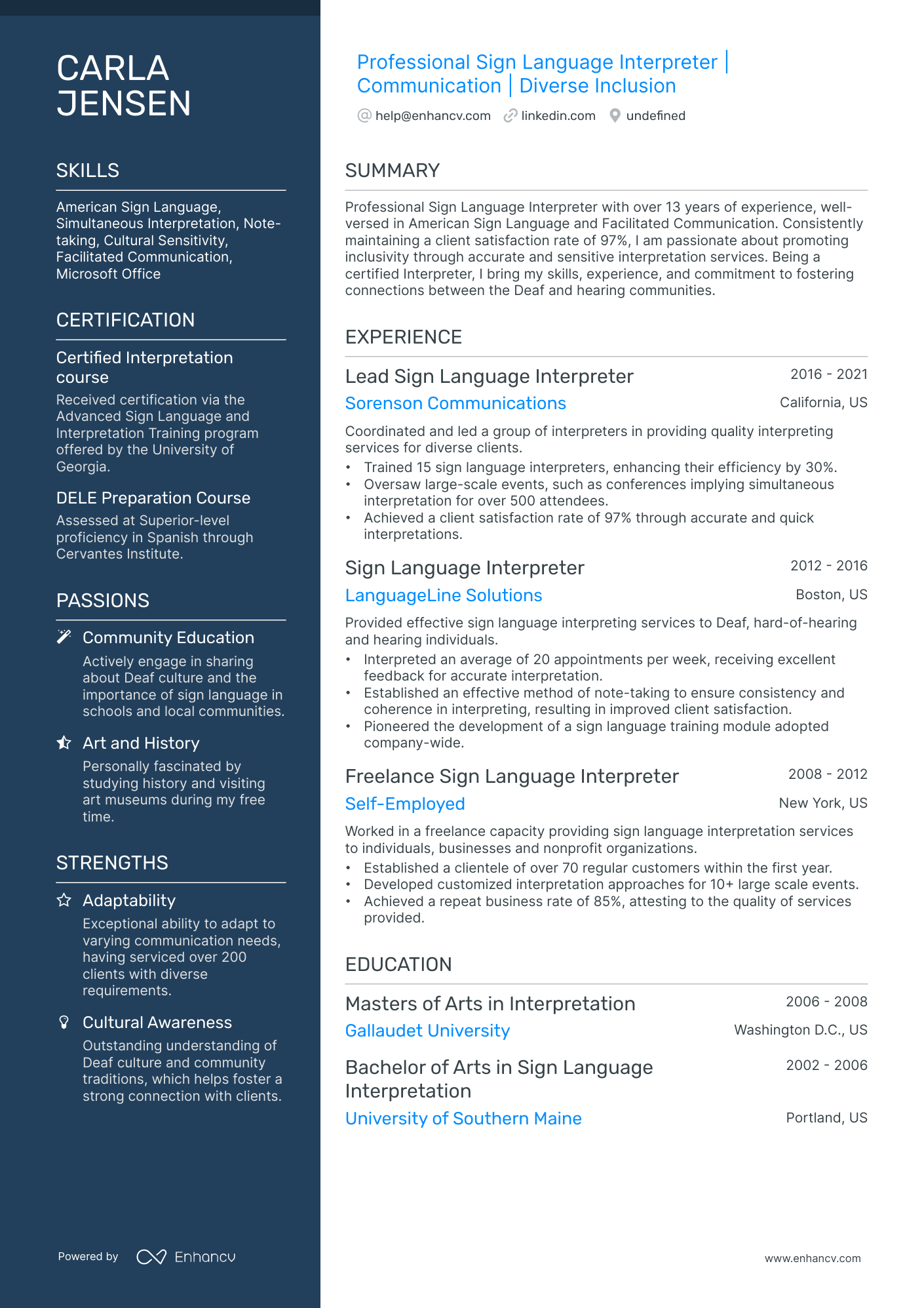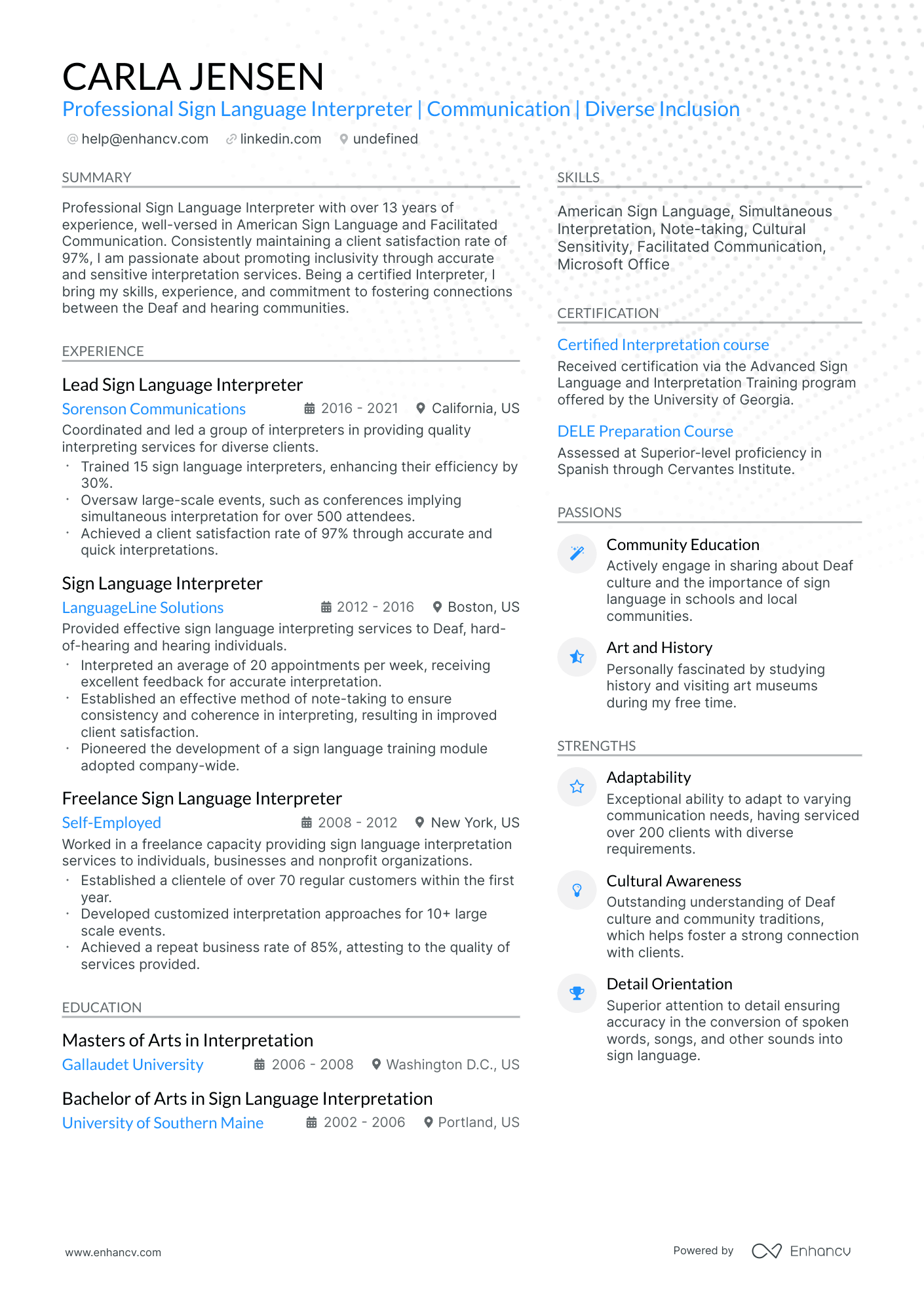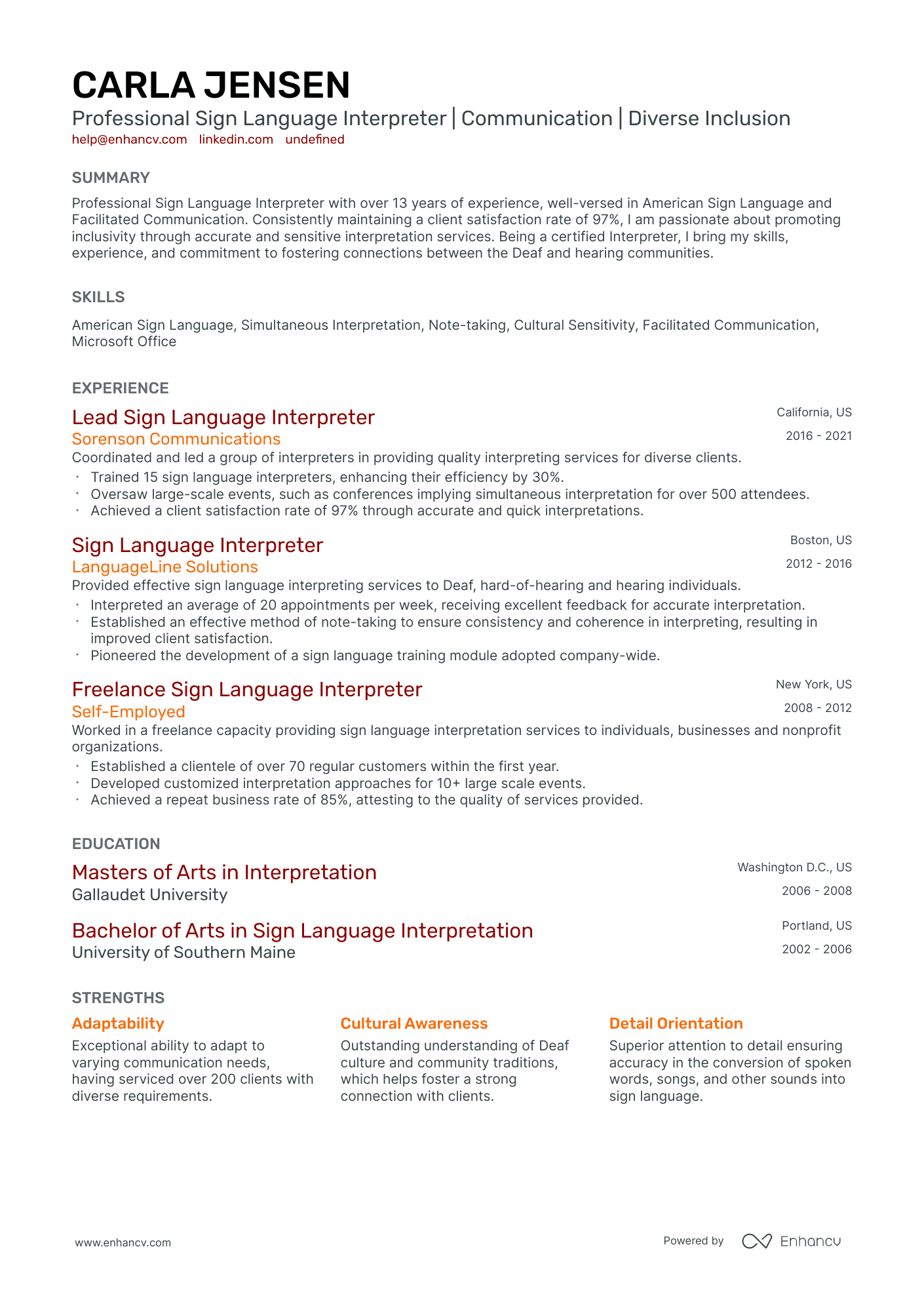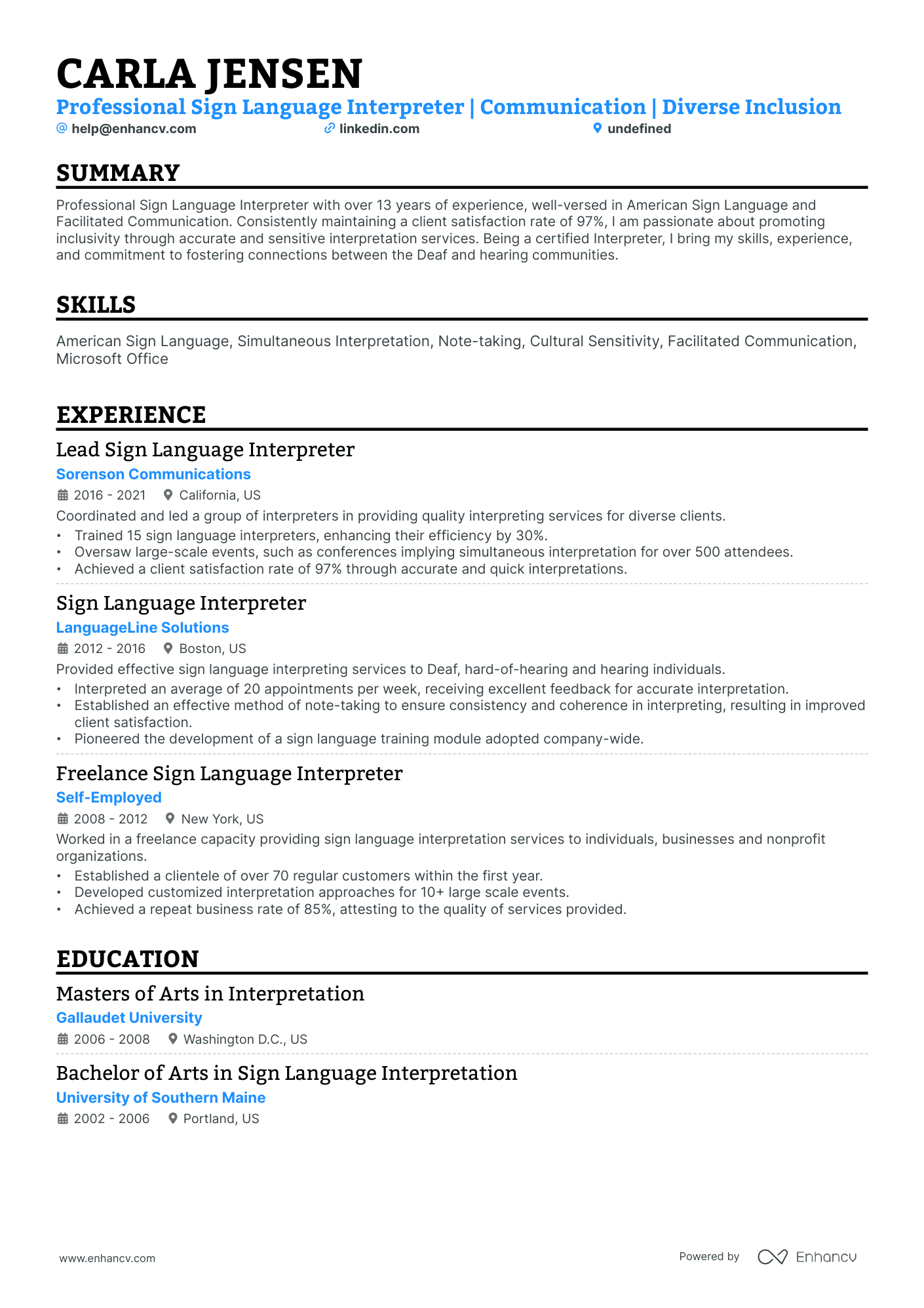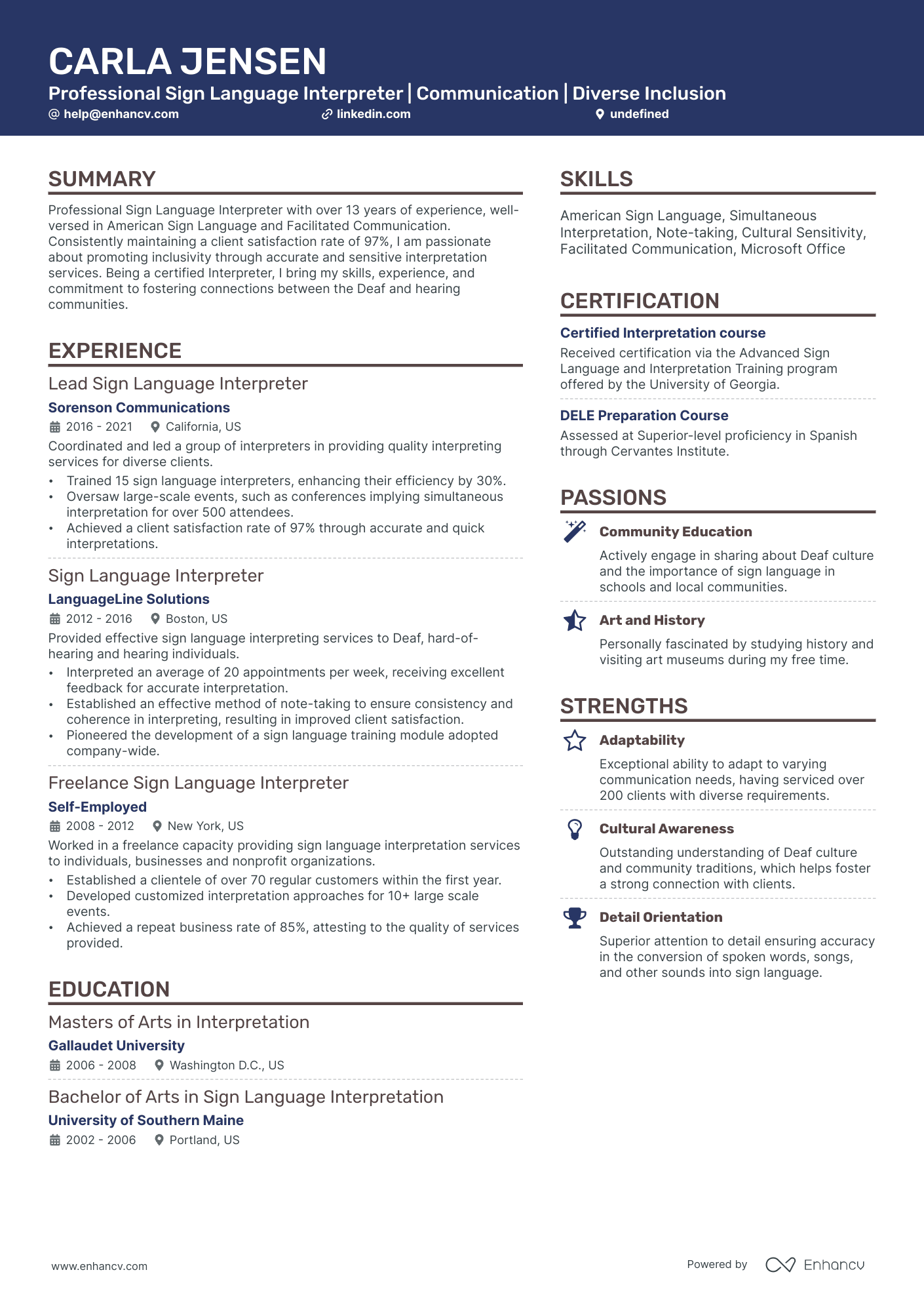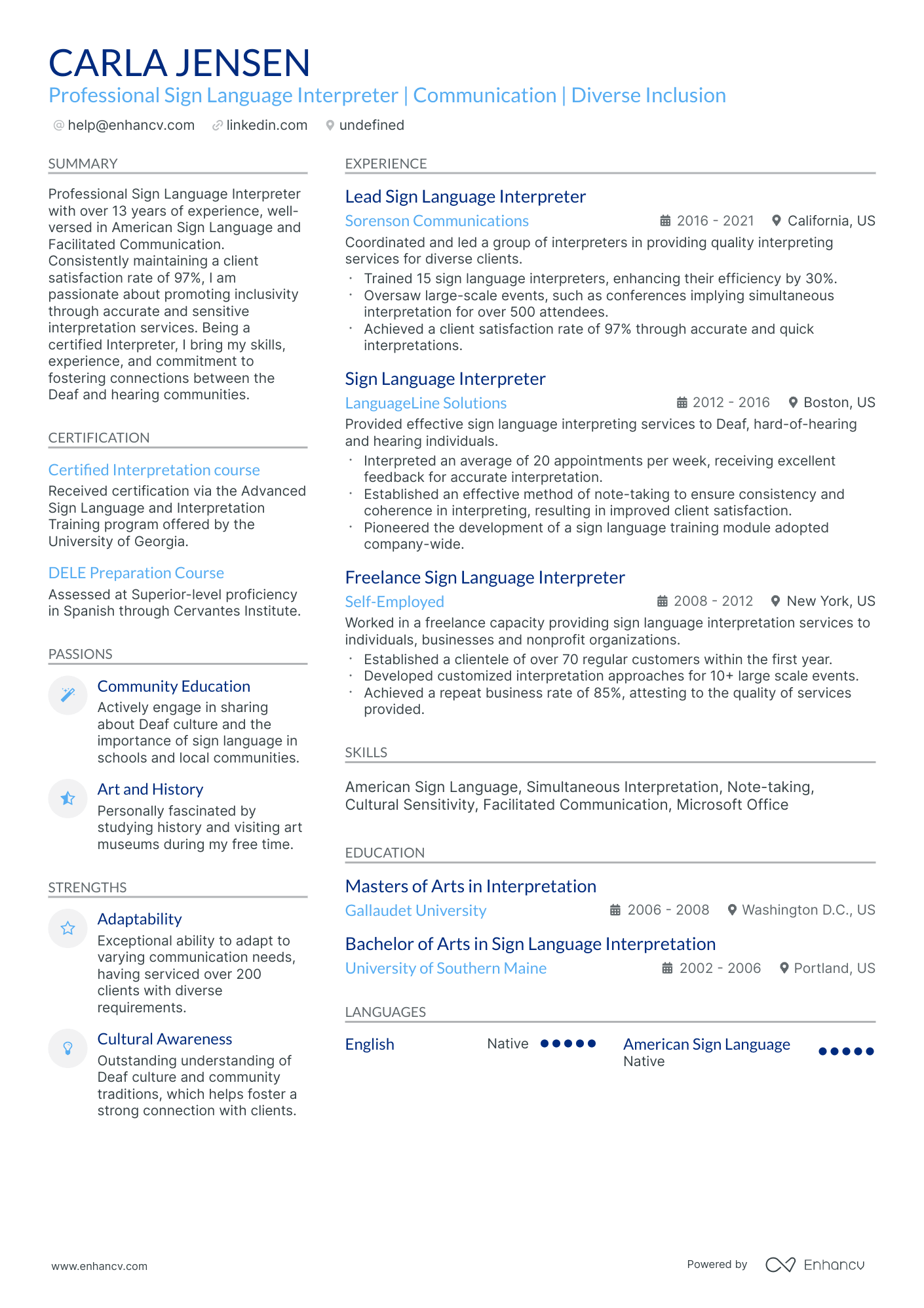Sign language interpreters often struggle with effectively illustrating their proficiency in a variety of sign languages and their related regional dialects on their resumes. Our guide can assist by providing strategies to quantitatively and qualitatively represent these skills, such as including certification levels, specific training courses taken, or instances where the interpreter successfully facilitated complex communication scenarios.
Stay tuned for more ideas on how to write your sign language interpreter resume:
- Find different sign language interpreter resume examples to serve as inspiration to your professional presentation.
- How to use the summary or objective to highlight your career achievements.
- How to create the experience section to tell your story.
- Must have certificates and what to include in the education section of your resume.
Recommended reads:
Structuring your sign language interpreter resume to engage recruiters
The presentation of your sign language interpreter resume is crucial.
Is it easy to read and well-organized? Does it have a logical flow?
Avoid overwhelming recruiters with a cluttered document. Instead, follow these best practices to ensure a consistent resume format:
- Include a header in the top third of your sign language interpreter resume for easy contact and quick access to your professional portfolio or LinkedIn profile.
- In the experience section, start with your most recent role and detail your career in a reverse-chronological order.
- Unless specified, submit your resume as a PDF to maintain its layout. Some companies might request other formats.
- If you're applying for a senior position and have over a decade of relevant experience, a two-page sign language interpreter resume is acceptable. Otherwise, aim for a single page.
Keep in mind the market you’re applying to – a Canadian resume, for instance, might have a unique layout.
Upload your resume
Drop your resume here or choose a file. PDF & DOCX only. Max 2MB file size.
Pro tip
Keep your sign language interpreter resume clear and concise. Top professionals narrate their career stories while highlighting their strengths.
Recruiters' top picks for sign language interpreter resume sections:
- A header with essential contact details and a headline showcasing your current role.
- A summary or objective that aligns your standout expertise with the role's demands.
- An experience section that delves into your key responsibilities and achievements.
- A skills section that intertwines job requirements with your unique capabilities.
- Education and certifications sections that bolster your professional credentials.
What recruiters want to see on your resume:
- Proficiency in American Sign Language (ASL) and other relevant sign languages: Demonstrating a high level of fluency is crucial for this role. Certifications from recognized institutions can serve as proof of proficiency.
- Experience in interpreting: Recruiters often prioritize candidates with experience, particularly in the specific contexts relevant to the position (e.g., education, legal, medical).
- Demonstrated knowledge of Deaf culture: Understanding the norms, values, traditions, and languages of Deaf communities is essential for effective communication.
- Certification by relevant authorities: In many places, national or regional certification (like the National Association of the Deaf or Registry of Interpreters for the Deaf in the U.S.) is required or strongly preferred.
- Evidence of continuing professional development: Recruiters appreciate interpreters who show commitment to updating their skills and staying current on best practices.
Recommended reads:
Detailing your relevant experience on your sign language interpreter resume
Showcase your credibility in the resume experience section. For an effective sign language interpreter resume:
- Highlight measurable achievements.
- Scan the job advert for keywords and integrate them throughout your experience section.
- Emphasize your technical proficiencies and how you've applied them in various roles.
- Keep it simple: mention your responsibility, relevant skills, and the outcomes.
- Use this section to convey your unique value, soft skills, feedback received, and the type of company culture you thrive in.
Top professionals ensure their experience section offers a captivating look at their expertise. Check out our sample sign language interpreter resumes for guidance.
- Provided sign language interpretation services for deaf and hearing-impaired individuals in educational settings, ensuring equal access to information.
- Collaborated with teachers and students to facilitate effective communication and promote inclusive learning environments.
- Translated complex technical concepts into American Sign Language (ASL), enabling students to grasp the material with ease.
- Facilitated communication between parents and educators during parent-teacher conferences, fostering strong partnerships and understanding.
- Led workshops on deaf culture and awareness, increasing knowledge and promoting inclusivity within the school community.
- Rendered sign language interpretation services in legal proceedings, including court trials, depositions, and client consultations.
- Collaborated with attorneys and legal professionals to ensure accurate and confidential communication with deaf clients.
- Prepared detailed written summaries of interpreted proceedings, maintaining comprehensive records for future reference.
- Interpreted complex legal documents and terminology, facilitating effective communication between deaf clients and legal teams.
- Contributed to the development of training materials for legal interpreters, enhancing professional standards and quality of service.
- Provided sign language interpretation services in medical settings, including hospitals, clinics, and rehabilitation centers.
- Assisted healthcare professionals in communicating with deaf patients, ensuring accurate diagnosis and treatment.
- Educated medical staff on deaf culture and effective communication strategies, improving patient care and satisfaction.
- Translated medical instructions and documents into ASL, enabling patients to understand their treatment plans.
- Facilitated support groups for deaf individuals, offering emotional support and promoting community engagement.
- Provide remote sign language interpretation services via video conferencing platforms for clients across various industries.
- Collaborate with diverse professionals, including business executives, educators, and healthcare providers, to facilitate effective communication.
- Adapt quickly to different subject matters, such as finance, education, and medical consultations, ensuring accurate information transfer.
- Utilize specialized software and technology tools for seamless remote interpretation, maintaining confidentiality and data security.
- Received positive feedback from clients regarding the ability to convey nuanced messages and maintain professionalism in virtual settings.
- Delivered sign language interpretation services in corporate environments, including meetings, conferences, and training sessions.
- Collaborated with business professionals to ensure effective communication between hearing and deaf employees.
- Interpreted technical presentations and discussions, allowing deaf participants to actively engage and contribute.
- Provided one-on-one coaching to deaf employees, supporting their professional development and career advancement.
- Contributed to the implementation of inclusive policies and practices, resulting in improved accessibility and diversity awareness.
- Served as a sign language interpreter in educational settings for students with special needs, ensuring effective communication and meaningful participation.
- Collaborated with teachers and therapists to develop individualized education plans (IEPs) for deaf students.
- Facilitated communication during therapy sessions, enabling students to achieve their therapeutic goals.
- Translated classroom materials into ASL, making the curriculum accessible and promoting learning outcomes.
- Supported students' social and emotional well-being by fostering inclusion and creating an inclusive classroom environment.
- Provide sign language interpretation services in the entertainment industry, including live performances, film sets, and television productions.
- Collaborate closely with actors, directors, and production crews to ensure accurate portrayal and representation of deaf characters.
- Prepare translated scripts and cues in ASL, synchronizing them with the dialogue and action on set.
- Assist with casting and audition processes, evaluating deaf actors' signing skills and providing feedback for character development.
- Received recognition for contributions to inclusive storytelling, resulting in increased representation and awareness of deaf culture.
- Provided sign language interpretation services in community settings, including public events, religious gatherings, and social programs.
- Collaborated with event organizers to ensure accessibility and equal participation for deaf attendees.
- Interpreted live performances, speeches, and presentations, conveying the intended message accurately and effectively.
- Assisted in developing sign language classes and workshops, empowering individuals to learn ASL and promote inclusivity.
- Organized fundraising events for local deaf organizations, raising awareness and financial support for their programs.
- Provided sign language interpretation services for deaf individuals in vocational rehabilitation programs, facilitating employment opportunities.
- Collaborated with vocational counselors and job coaches to develop effective communication strategies in workplace settings.
- Translated job training materials and employment-related documents into ASL, ensuring access to critical information.
- Conducted mock interviews and job readiness workshops, equipping deaf individuals with essential skills for successful employment.
- Supported clients in navigating workplace challenges, resulting in increased job retention and satisfaction rates.
- Provided sign language interpretation services in post-secondary education settings, promoting equal access to higher education for deaf students.
- Collaborated with professors and students to ensure effective communication in lectures, discussions, and academic activities.
- Translated course materials, textbooks, and exams into ASL, accommodating diverse learning styles and preferences.
- Assisted deaf students in accessing online platforms and educational technology, fostering inclusive e-learning environments.
- Participated in the development of accessibility policies and practices, resulting in improved support for deaf students.
The following content includes information from "O*NET OnLine" by the U.S. Department of Labor, Employment and Training Administration (USDOL/ETA). Used under the CC BY 4.0 license. The data represents the top responsibilities present on the task lists for sign language interpreter professionals.
Top Responsibilities for Sign Language Interpreter:
- Translate messages simultaneously or consecutively into specified languages, orally or by using hand signs, maintaining message content, context, and style as much as possible.
- Listen to speakers' statements to determine meanings and to prepare translations, using electronic listening systems as necessary.
- Compile terminology and information to be used in translations, including technical terms such as those for legal or medical material.
- Refer to reference materials, such as dictionaries, lexicons, encyclopedias, and computerized terminology banks, as needed to ensure translation accuracy.
- Check translations of technical terms and terminology to ensure that they are accurate and remain consistent throughout translation revisions.
- Identify and resolve conflicts related to the meanings of words, concepts, practices, or behaviors.
- Compile information on content and context of information to be translated and on intended audience.
- Adapt translations to students' cognitive and grade levels, collaborating with educational team members as necessary.
- Check original texts or confer with authors to ensure that translations retain the content, meaning, and feeling of the original material.
- Adapt software and accompanying technical documents to another language and culture.
Quantifying impact on your resume
<ul>
Addressing a lack of relevant sign language interpreter experience
Even if you lack direct sign language interpreter experience, you can still craft a compelling resume. Here's how:
- Highlight projects or publications that demonstrate your relevant skills or knowledge.
- Emphasize transferable skills, showcasing your adaptability and eagerness to learn.
- In your objective, outline your career aspirations and how they align with the company's goals.
- Consider a functional or hybrid resume format, focusing on skills over chronological experience.
Pro tip
Your experience section should be a testament to your professional growth. If your career journey isn't particularly linear or impressive, focus on detailing specific skills and the tangible outcomes of your responsibilities.
Sign language interpreter resume skills: showcasing both hard and soft skills
Your sign language interpreter resume should show recruiters your range of skills. List the tools and software you use (hard skills) and how they fit into your daily tasks. But don't stop there. Share the personal traits (soft skills) you've gained from your experiences. Here's how:
- Showcase three top career achievements.
- For each achievement, mention a hard and a soft skill you used.
- Highlight unique skills that set you apart.
- Discuss how your skills improved the workplace or team culture.
Check our list for popular hard and soft skills in the industry.
Top skills for your sign language interpreter resume:
American Sign Language (ASL)
Video Relay Service (VRS)
Computer-Assisted Real-Time Translation (CART)
Sign Language Interpreting Software
Captioning Tools
Speech-to-Text Technology
Mobile Interpreting Applications
Remote Interpreting Platforms
Deaf Culture Knowledge
Interpreting Ethics and Standards
Effective Communication
Empathy
Cultural Sensitivity
Active Listening
Adaptability
Problem Solving
Time Management
Team Collaboration
Attention to Detail
Professionalism
Next, you will find information on the top technologies for sign language interpreter professonals from "O*NET OnLine" by the U.S. Department of Labor, Employment and Training Administration (USDOL/ETA). Used under the CC BY 4.0 license.
Top technologies for Sign Language Interpreter’s resume:
- Extensible hypertext markup language XHTML
- Hypertext markup language HTML
- Microsoft PowerPoint
- AceTools.biz Ace Translator
- Stormdance CatsCradle
Pro tip
Don't go all over the place with your skills section by listing all keywords/ buzzwords you see within the ad. Curate both hard and soft skills that are specific to your professional experience and help you stand out.
Highlighting sign language interpreter-specific certifications and education
Your resume education section can be a treasure trove of skills and experiences relevant to the role. Here are the best practices when it comes to featuring it on your resume:
- Highlight advanced qualifications, detailing the institution and duration.
- If you're currently pursuing a degree, mention your expected graduation date.
- Consider omitting unrelated degrees.
- If your academic journey boasts significant achievements, especially in research, elaborate on them.
What's more, shocasing relevant industry certifications can bolster your credibility, even if you lack extensive work experience.
To effectively present your certifications:
- Place pivotal industry certifications prominently in a dedicated section.
- If a certification is particularly impressive, consider featuring it near your name or within the header, summary, or objective.
- Provide details, where relevant, to underscore alignment with the role.
- Recent certifications should be given advantage, as they show your up-to-date knowledge.
Both education and certification sections highlight your commitment to professional growth, a trait valued by employers. Below, explore some of the most current and sought-after sign language interpreter certifications to enhance your application:
Best certifications to list on your resume
- Association of Visual Language Interpreters of Canada (AVLIC) - Certificate of Interpretation (COI)
- National Association of the Deaf (NAD) - NAD IV/V Certification
- Boys Town National Research Hospital - Educational Interpreter Performance Assessment (EIPA)
- Telecommunications for the Deaf and Hard of Hearing, Inc. (TDI) - Certified Legal Interpreter (CLI)
- British Sign Language Board (BSLB) - Level 6 NVQ Certificate in British Sign Language
Pro tip
If you're in the process of obtaining a certification listed in the job requirements but haven't completed it yet, be transparent. Mention your ongoing training and the expected completion date. Honesty is always the best policy on a resume.
Recommended reads:
Choosing between a resume summary or objective based on your experience
The relevance of a resume summary or a resume objective for your sign language interpreter application hinges on your experience.
Both provide a snapshot of your expertise and accomplishments. However:
- A resume objective emphasizes your career aspirations, ideal for candidates looking to balance their experience with future goals.
- A resume summary offers a space to detail your unique value and notable accomplishments, perfect for candidates with a rich career history.
Ensure your introduction aligns with the job description, and if possible, quantify details for a compelling narrative.
Resume summary and objective examples for a sign language interpreter resume
- Qualified sign language interpreter with over 10 years of experience in facilitating effective communication between the hearing and the deaf community. Fluent in American Sign Language and English, skilled at sign-to-voice, voice-to-sign and tactile methods. Notable achievement in translating complex medical information to patients at XYZ Hospital.
- Experienced professional with a decade-long history in education, making a pivot toward sign language interpretation. With a certification in American Sign Language (ASL), and a knack for learning new languages quickly, I am ready to leverage my exceptional interpersonal skills to bridge the communication gap wherever required.
- Dedicated sign language interpreter boasting 8 years of expertise in educational settings. Proficient in various sign language systems including ASL and SEE, with a track record in providing accurate translations during school board meetings at ABC School District.
- Career transition from social work to sign language interpreting, armed with an intimate understanding of deaf culture and a certification in ASL. Eager to use my innate empathy and patient demeanor to foster clearer communication while maintaining respect for all participants in the conversation.
- A newly certified graduate passionate about providing top-notch sign language interpreting services to support clear communication. Ambitious and dedicated, my goal is to utilize my strong command of both ASL and English in any setting where they are needed.
- Recent graduate with a degree in Communication Disorders seeking a role as a sign language interpreter. My aim is to contribute my knowledge of ASL and my ability to quickly grasp context and cultural nuances to ensure effective, respectful communication for all parties involved.
Optimize your resume summary and objective for ATS
Drop your resume here or choose a file.
PDF & DOCX only. Max 2MB file size.
Extra sections to boost your sign language interpreter resume
Recruiters love candidates who offer more. Share your personality or extra industry credentials. Consider adding:
- Projects showcasing standout work.
- Top awards or recognitions.
- Relevant publications.
- Hobbies and interests that reveal more about you.
Key takeaways
- Pay special attention to the tiny details that make up your sign language interpreter resume formatting: the more tailored your application to the role is, the better your chances at success would be;
- Select the sections you include (summary or objective, etc.) and formatting (reverse-chronological, hybrid, etc.) based on your experience level;
- Select experience items and, consequently, achievements that showcase you in the best light and are relevant to the job;
- Your profile will be assessed both based on your technical capabilities and personality skills - curate those through your resume;
- Certifications and education showcase your dedication to the particular industry.
